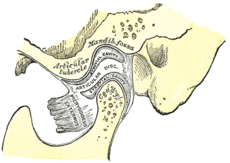- Dislocation of jaw
-
Dislocation of jaw Classification and external resources 
Sagittal section of the articulation of the mandible.ICD-10 S03.0 ICD-9 830 eMedicine article/823775 There can be a dislocation of jaw if a person opens their mouth too wide, particularly when a person attempts to open the jaw widely in an effort to stretch the facial muscles i.e. to relieve tense facial muscles as the wisdom teeth develop and emerge. Dislocation can occur following a series of events if the jaw locks wide open and is unable to close by using the jaw muscles (unassisted) and without excessive force;. As an immediate result of the dislocation, chronic pain can be experienced on both sides of the jaw, combined with an extreme headache and inability to concentrate.
Depending on the severity of the jaw's dislocation, pain relief using paracetamol can assist to alleviate the initial chronic pain, however the effects of long-term use of paracetamol can decline as the condition deteriorates with continued use of the jaw through the day i.e. talking, eating, smoking, drinking, etc.
Symptoms
The symptoms can be numerous depending on the severity of the dislocation injury and how long the person is inflicted with the injury.
The immediate symptom can be a loud crunch noise occurring right up against the ear drum. This is instantly followed by excruciating pain, particularly in the side where the dislocation occurred.
Short-term symptoms can range from mild to chronic headaches, muscle tension or pain in the face, jaw and neck.
Long-term symptoms can result in sleep deprivation, tiredness/lethargy, frustration, bursts of anger or short fuse, difficulty performing everyday tasks, depression, social issues relating to difficulty talking, hearing sensitivity (particularly to high pitched sounds), tinnitus and pain when seated associated with posture while at a computer and reading books from general pressure on the jaw and facial muscles when tilting head down or up. .
Injury: Dislocations/subluxations, sprains and strains (Sx3 where x=0 to 9, 830–848) Joints and
ligamentsMuscles and
tendonsM: JNT
anat(h/c, u, t, l)/phys
noco(arth/defr/back/soft)/cong, sysi/epon, injr
proc, drug(M01C, M4)
Categories:- Injuries of head
- Dislocations, sprains and strains
- Medicine stubs
Wikimedia Foundation. 2010.
